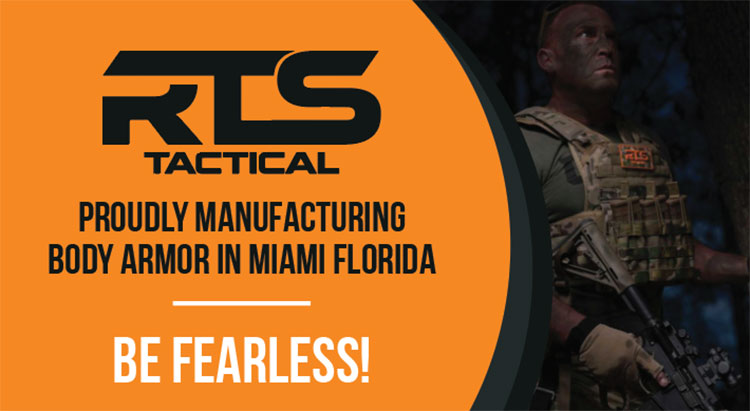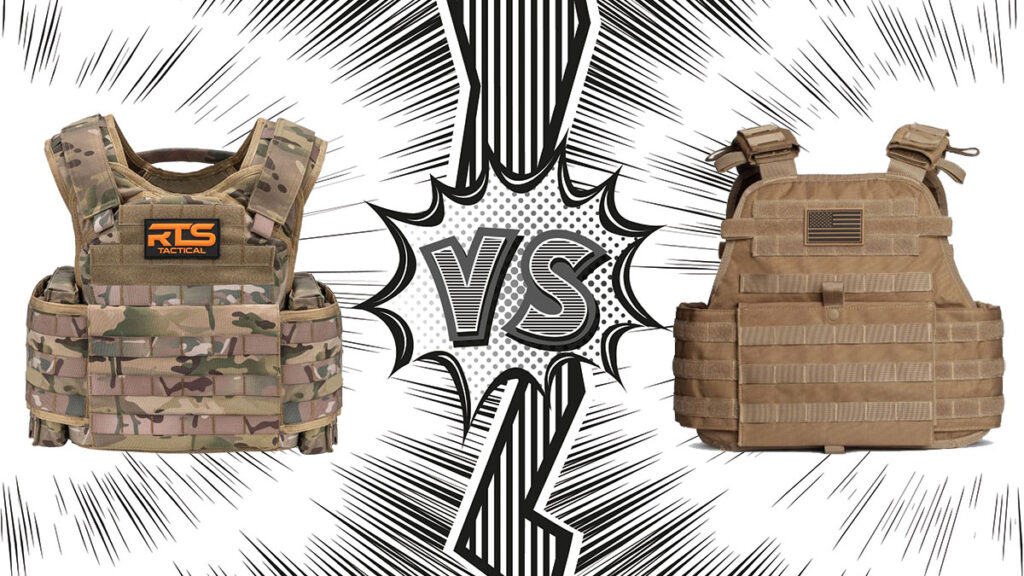
There are so many different companies selling body armor on the civilian market these days that it can be challenging to sort through which company you should buy from. What level of protection do you need?
Will AR500 suffice or do you need something more? What makes AR600 armor better (or worse) than AR550 armor?
It’s confusing, and while I can’t help you sort through all of that in a single post, I hope this article comparing RTS Tactical’s AR600 plates with Infidel’s AR550 plates will yield some information to help sort through the confusion. It’s not a perfect comparison; however, the comparison will still prove informative for the civilian looking to armor up!
The Body Armor Market
The body armor market is large and growing. The market size was valued at 2.45 billion USD in 2021 and is expected to grow to 3.53 billion USD by 2028 (source). The civilian portion of that market is small in comparison to military and police, but it is a growing market nonetheless.
I have witnessed the growth in companies marketing body armor to civilians over the years. When I started blogging here in 2007, buying personal body armor was rarely discussed in prepper circles. Now it seems there’s a new company popping up every few months trying to get a slice of the market.
This article is a reflection of that, covering two different plates from just two of the many companies out there: RTS Tactical and Infidel.
I like, and have worked with, both companies. Infidel reached out to me early on to test their product, which we did. Great company and great service. RTS Tactical came to me later, also offering a great product with great service.
As with all things, however, there are differences between the two companies’ products. Here I am comparing their Level NIJ 0101.06 armored plates.
What is NIJ 0101.06 Body Armor?
NIJ Standard-0101.06 is a ballistic resistance rating that establishes the minimum performance requirements for personal body armor. It can be used by body armor shoppers to inform their decision making on the level of protection they want to buy.
As I mentioned, we tested the Infidel NIJ 0101.06 plate at the shooting range (read the review). Based on our test, this plate stopped the following:
- 9mm Speer 124gr Gold Dot JHP
- .357 Magnum 158gr Super-X JHP
- .44 Magnum Speer 200gr JHP
- .223 Hornady 62gr Barrier Penetrator TAP
- .308 Hornady 168gr A-MAX TAP
- .300 Short-Action Ultra-Mag Barnes 150gr TSX Handload
- .350 Remington Magnum, Hornady 200gr SP Interlock Handload
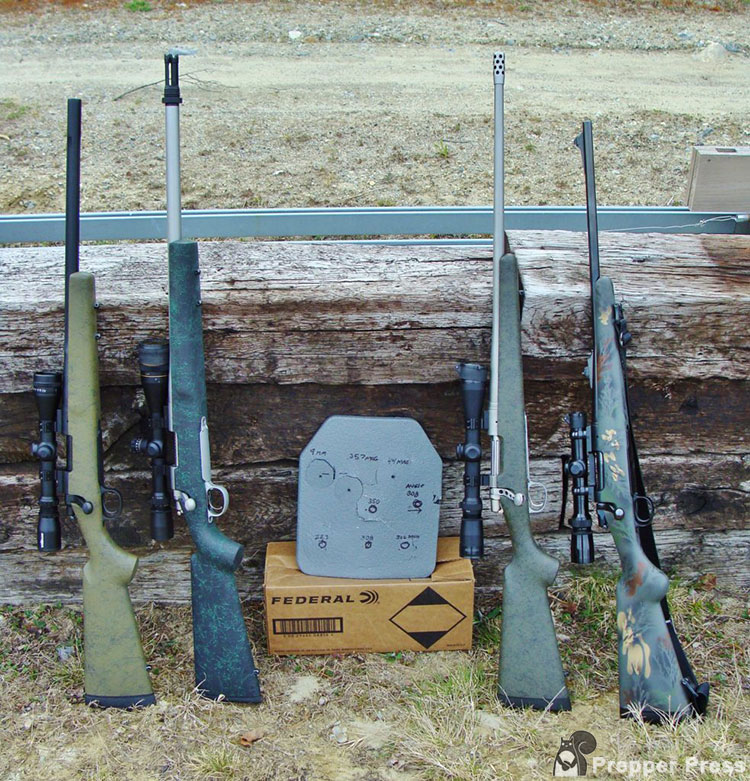
Impressive? I think so.
Want to see a test of AR600 just the same? This video will help:
AR500 vs AR550 vs AR600 Body Armor
Most hard body armor plates on the market are going to be either AR500, AR550 or AR600. These represent different levels of abrasion resistant (AR) ballistic steel. AR550 is most widely found in the commercial body armor market and they can defeat all of the rounds listed above, including the common M855 round. All of these plates pass the NIJ 0101.06 threat levels.
All of these plates will provide suitable bullet resistance for the consumer. There are differences, however.
AR500 – AR500 steel is made of a steel alloy blend and has great wear resistance. AR500 armor plate has been used by the military, security contractors, etc. The big advantage to this steel plate is that it comes at a lower cost for the consumer. AR500 plates typically have a twenty-year shelf life. You will see AR500 advertised as “Level III” armor.
AR550 – AR550 steel is stronger and more durable than AR500. For a bit more money, the buyer can have an even higher level of protection. You will see AR550 advertised as “Level III+” armor.
AR600 – AR600 steel plates has even more protection than 550 plates. You will see AR600 advertised as “Level III+” armor.
Is more always better? Not necessary. Higher-end armor comes at a higher cost. However, it can also be more convenient to wear (as we’ll see in a moment), but the reverse can also be true.
The National Institute of Justice Guide: Body Armor states that for law enforcement officers looking for handgun protection, Level IIA or IIIA is appropriate. This makes sense for the officer who is walking the beat, for example. Wearing heavy combat-style armor can be too tiring, hot, and just unnecessary for practical use. This armor is generally easier to wear and conceal.
Hard armor, Level III and up, is more appropriate for hostile environments. The downside is that the plates are heavier, bulkier, and more difficult to conceal.
RTS Tactical AR600 vs Infidel AR550 Plates
As noted above, the RTS Tactical and Infidel’s plates being compared are rated at the NIJ 0101.06 minimum standard. Given that we already tested the AR550 plate at the range, and knowing that these plates must meet the standard in order to be labeled as such, I was not interested in shooting up the RTS AR600 plate just to prove (again) that plates of this rating can stop high-powered bullets with little problem.
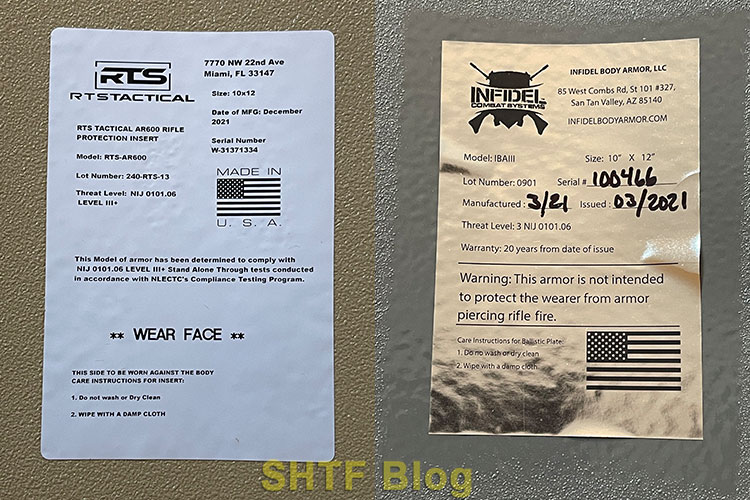
Assuming the same performance (albeit a bit better with AR600), I instead want to compare other aspects of the plates.
But if the plates have the same rating, aren’t they more or less the same?
No.
The RTS plates here, beyond being AR600, include a “high-performance polyurea coating” to deliver “superior spall containment” (reduces deflection of projectile fragments). There are other differences illustrated in the chart below.
| RTS Tactical | Infidel | |
|---|---|---|
| Rating | NIJ 0101.06 | NIJ 0101.06 |
| Size | 10″ x 12″ | 10″ x 12″ |
| Weight (single plate) | 7.9lbs | 9lbs |
| Plate Thickness | 5/16″ | 1/2″ |
| Manufacturer’s Shelf-Life | 10 years | 20 years |
| Cost (set of 2 plates) | $259.99 | $299.99 |
The RTS Tactical’s AR600 plates, in addition to slightly better protection, are thinner and lighter than Infidel’s AR500 plates. This makes them easier to wear for extended periods of time. As of this writing, the AR600 plates also cost a bit less. However, the AR550 plates have twice the shelf-life (20 years vs 10).
For comparison’s sake, RTS Tactical AR500 plates can be purchased for $199.99.
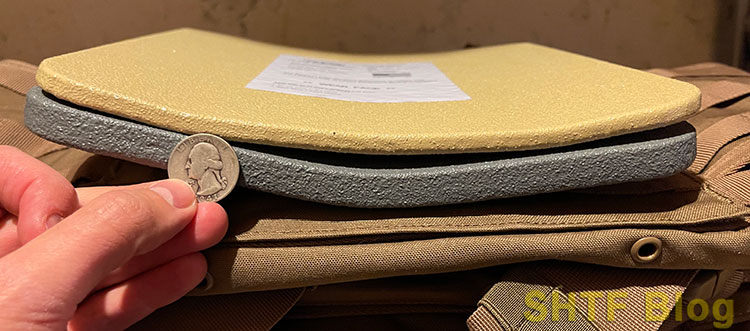
How does RTS Tactical offer better protection in a smaller plate? It’s in the construction. Again, however, this comes at the “cost” of half the shelf life of the AR550 plates.
Which is Best?
The “best” level of protection may not be the “best” choice for the consumer; however, it could be. Buyers need to compare the protection level of the body armor versus the weight, cost, and shelf-life of the plates themselves.
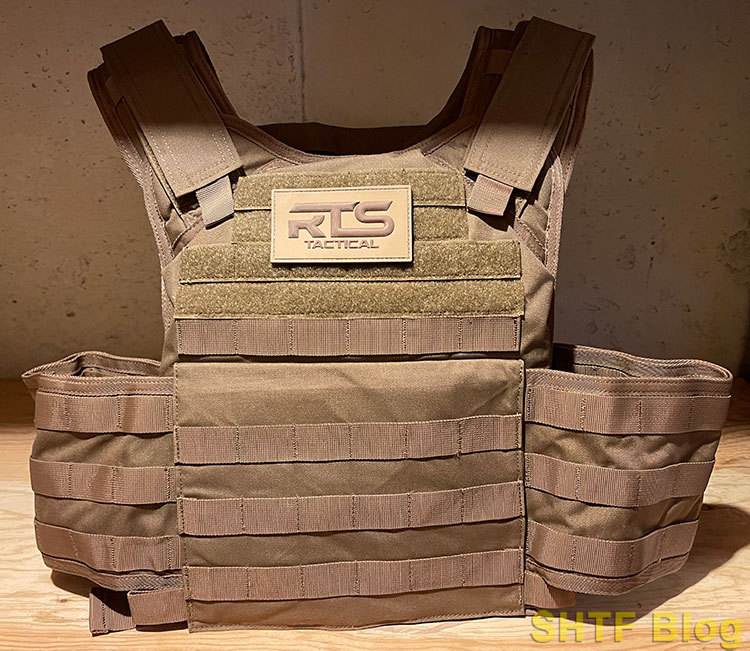
Unfortunately, there is no one-size-fits-all approach to selecting civilian body armor.

